Smoked Pork Butt Recipe
This Smoked pork butt recipe is well seasoned and slow-cooked in apple wood, making tender, flavorful meat that you won’t be able to stop eating. I’ve smoked hundreds of pork butts, but when it’s simple like this with proper cooking techniques, it’s always incredibly delicious.
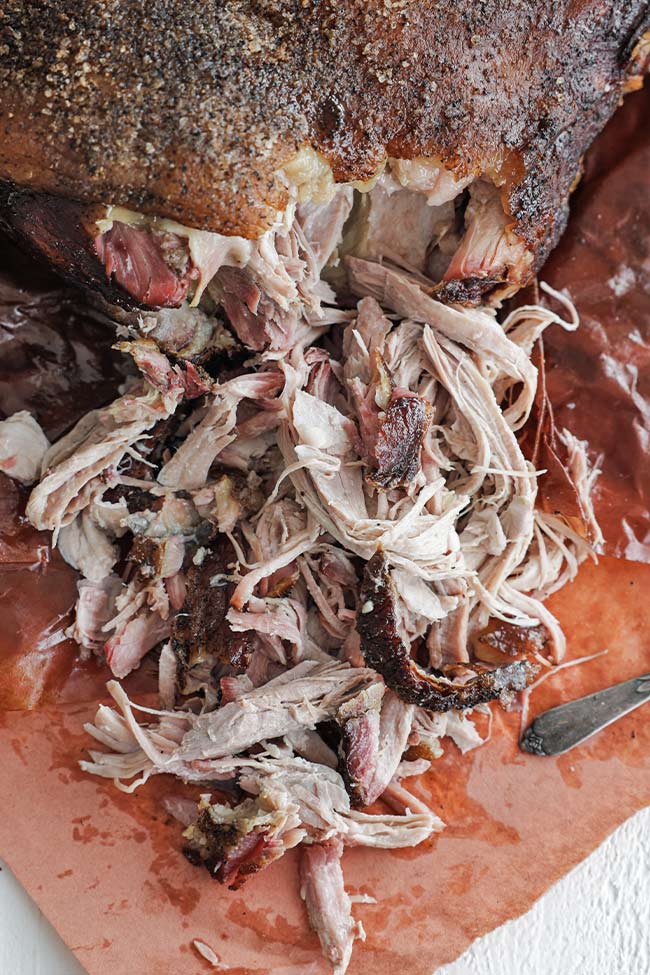
I love BBQ and smoking different meats. The final product is always so good whenever I throw something on the smoker. If you want to try new recipes, check out my smoked leg of lamb or cured and smoked ham.
Smoked Pork Butt
Smoked pork butt consists of a cut of pork that is slow cooked in a smoker or a pit for long periods and very low temperatures. During this time, the muscle fibers slowly break down, and the fat renders, resulting in a flavorful, juicy, tender pork butt.
The other important part to ensure it is delicious is the bark that forms on the outside. This chemical reaction takes place, including caramelization and the Maillard reaction. When it is created, it is the most coveted part of the final result because it’s so flavorful.
Due to the lower cooking temperatures, you can expect this to take roughly 1 hour per pound of smoking, regardless of weight. In addition, this cooking method is much more about internal temperature than it is about time. The pork butt needs to hit certain internal temperatures before it can move to the next stage.
Ingredients and Substitutions
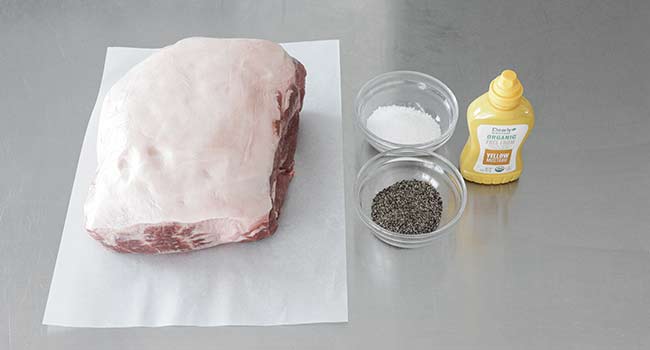
- Pork – You will need a bone-in pork butt for this recipe. This is also called a Boston Butt and is a cut of pork that is higher up on the shoulder but separate from the picnic shoulder cut.
- Mustard – Plain yellow mustard is used as a binder to help seasonings stick.
- Seasoning – I only used coarse salt and ground black pepper. These will not mask the taste at all. However, you can make your own BBQ rub or even add ¼ cup of sugar to this mix if you want a sweeter pork butt.
How to Make Smoked Pork Butt
Coat: I start by coating the pork butt on all sides with the mustard.
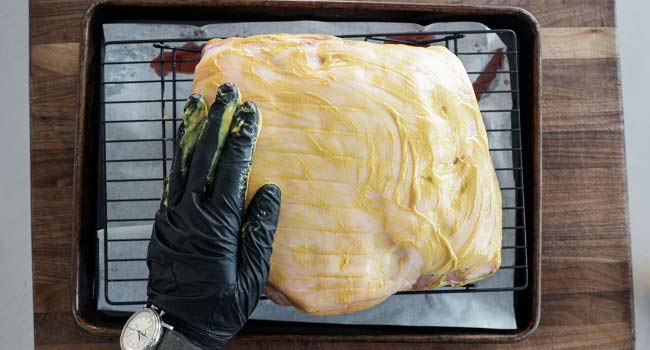
Season the pork: Next, I generously season it on all sides with salt and pepper. It’s essential that all 6 sides of the butt are seasoned for maximum flavor.
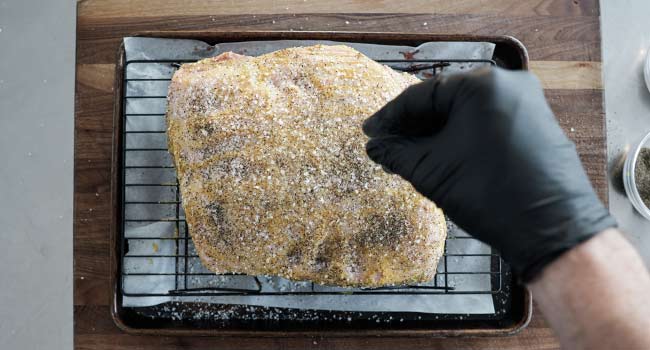
Preheat the smoker to 250°: Once heated, I place the seasoned pork on the grates and place a thermometer in the center of it. I like putting it on a top grate with a pan below to catch any drippings and avoid “grease” smoking. Smoke until the butt stalls, which is usually between 160° and 165°.
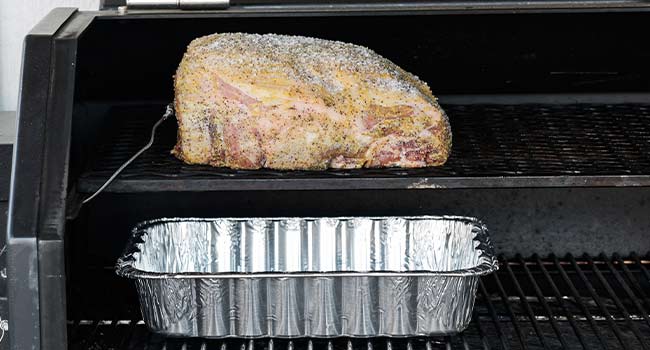
Keep it moist: If you notice any spots drying out on the top or sides of the pork, feel free to spray some BBQ spritzer on it. This will help add flavor, tenderize the pork, and prevent that area from crisping up too much.
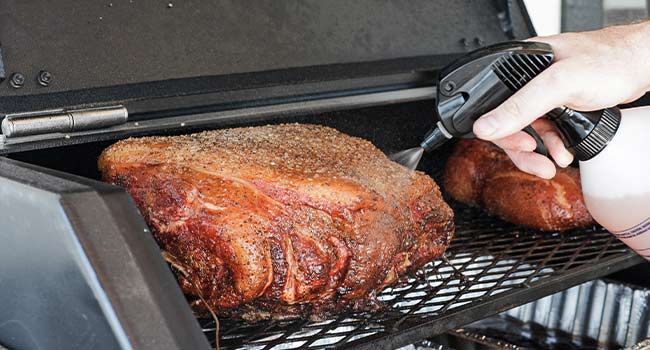
Place: I remove the pork and place in two sheets over overlapped butcher’s paper roughly 3 feet long.
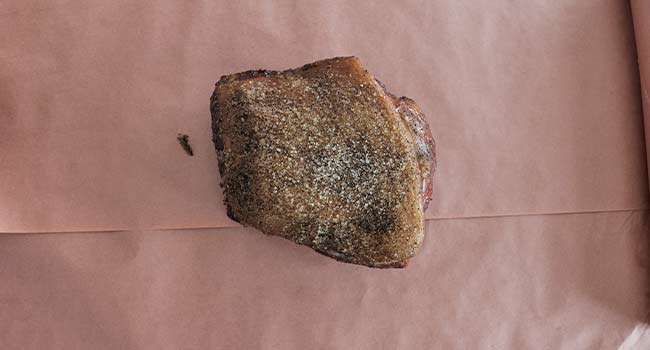
Wrap it up: I fold the bottom part of the paper up to wrap around the pork.
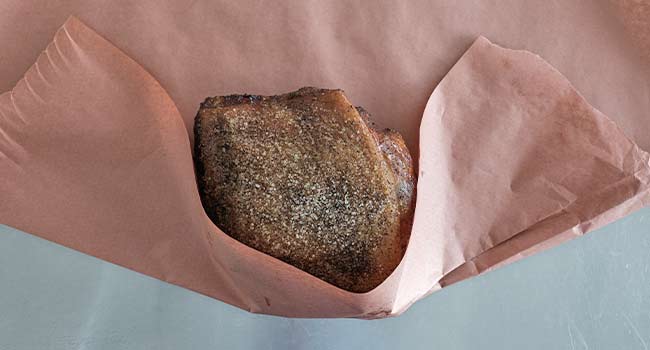
Fold the paper: Next, I fold the paper right over left.
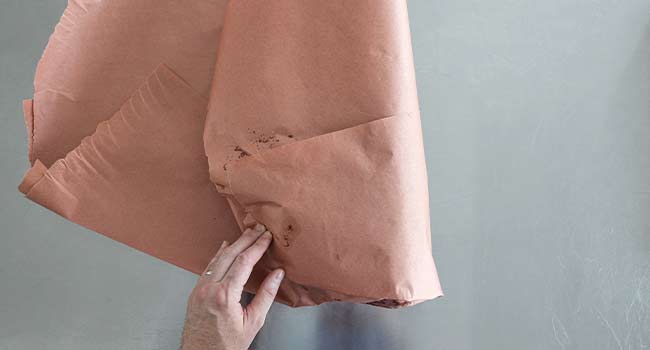
Fold it again: After folding the right side over the pork, I bring the left side across to finish wrapping it snugly.
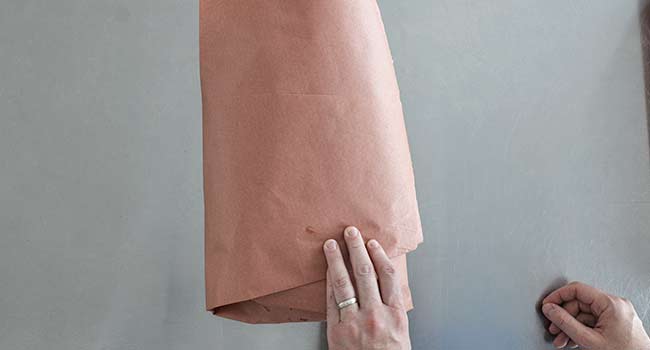
Roll the pork: I carefully roll the butt forward so the fat cap stays on top and the seams of the paper end up underneath.
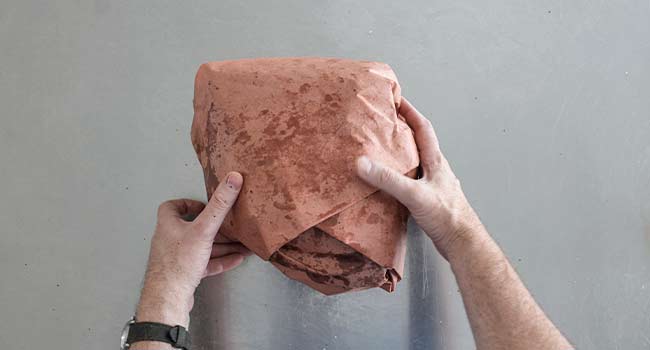
Return to the smoker: I place the wrapped pork butt right back where it was on the smoker and insert the thermometer again into the center.
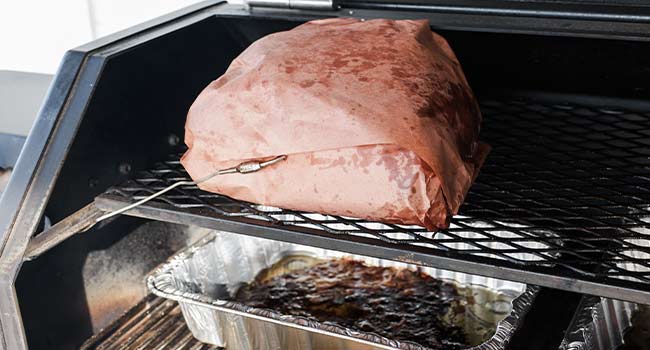
Cook: I smoke the pork until it reaches at least 202° or more. Although pork will technically shred starting at 190°, I find it to be juicier and more tender when pushed to 202° plus. I remove it and let it rest at room temperature for 30 to 45 minutes. You can let it rest for even longer. If you decide to do that, keep it well insulated, like in a cooler, to help keep temperatures above the 140° danger zone.
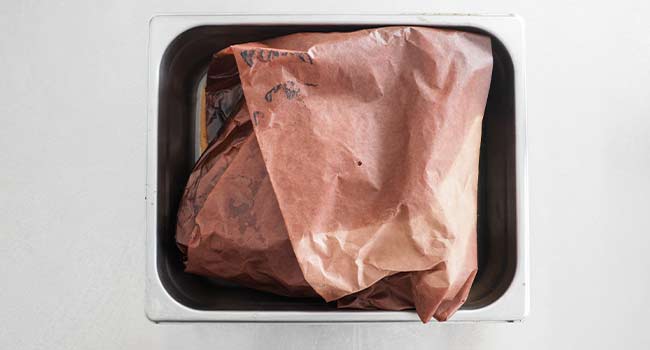
Shred the pork: Once it’s rested, I go in with my hands or two big forks and pull it apart. It should fall apart easily and be super juicy.
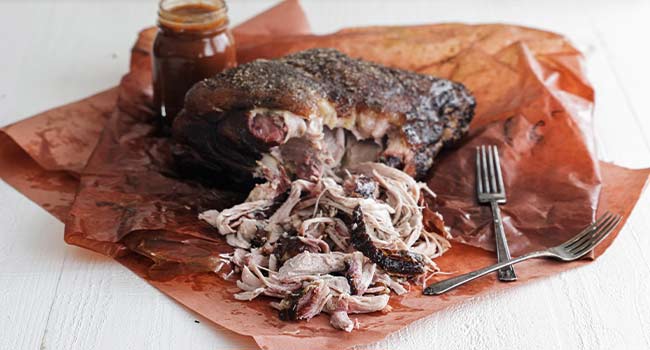

Chef Tip + Notes
While I wrapped the pork in peach or butcher’s paper, you can also use aluminum foil. The butcher’s paper is porous enough to let smoke in while keeping the bark intact. Rendered pork fat and juices will not cause holes in the paper as it smokes.
- Smoker options: I used a pellet smoker for this recipe, but you can definitely use a charcoal grill, offset smoker, smoker pit, or digital smoker too.
- Brining or injecting: Sometimes I’ll brine the meat or inject it with a mix of vinegar, juice, and seasoning for extra flavor and moisture.
- Using pork lard: Try using pork lard instead of the mustard, a binder for the salt and pepper.
- Dry brine option: You can skip the mustard and do a dry brine by seasoning with salt and pepper and letting it chill uncovered in the fridge for up to 48 hours.
- Cold start for smokier flavor: Pellet smokers tend to produce on the lighter side of smoke infused into the food. Because of that, I do not pull the pork butt out of the fridge too early before smoking so that the extra time in the smoker can be used to get smokier flavors.
- Wood choices: My favorite woods for this are alder, cherry, apple, oak, pecan, and hickory.
- Smoking temp: Temperatures for smoking a pork butt can vary from 200° to 275°.
- The stall: The stall refers to a period of time during which the pork stands still at the same temperature for longer than usual. Sometimes, it can go quickly, and sometimes, it can take hours, which is why we wrap it to help move it along.
- Maillard reaction: Maillard reaction, also known as the browning reaction, is an interaction between sugar and amino acids in the steak when heated to 285°and 350° over high heat, browning the meat to enhance the flavor and add more crispness. This is not the same as caramelizing.
Serving Suggestions
I love serving this creamy coleslaw alongside my pulled pork with BBQ sauce for pulled pork, it’s the perfect cool contrast to all that smoky flavor. If I’m making sandwiches, I’ll pile everything onto a batch of my homemade hamburger buns for the ultimate BBQ plate.
Make-Ahead and Storage
Make-Ahead: You can make this up to 8 hours ahead. If you do this, keep it covered and in the oven or warmer at low temperatures (<180°).
How to Store: Cover and keep it in the fridge for up to 5 days. Freeze it covered for up to 6 months. Thaw it in the refrigerator for one day before reheating.
How to Reheat: Add the desired amount of smoked pork butt to a baking dish or pot with a lid, along with 1 cup of chicken stock or water, cover, and bake in the oven at 300° for 25 to 30 minutes or until warm. If you don’t want BBQ, try using it in my Pork Pozole Recipe.
More Smoked Recipes

Smoked Pork Butt Recipe
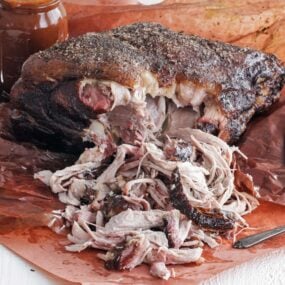
Ingredients
- 10 to 12 pound bone-in Pork Boston Butt
- ¼ cup yellow mustard
- 2 tablespoons coarse salt, you may need an additional tablespooon
- 1 tablespoon ground black pepper
Instructions
- Preheat the smoker to 250°. Start by coating the pork butt on all sides with the mustard.
- Next, generously season it on all sides with salt and pepper. It’s important that all 6 sides of the butt are seasoned for maximum flavor.
- Place the seasoned pork butt on the grates and place a thermometer in the center of it. I like to place it on a top grate with a pan below to catch any drippings to avoid any “grease” smoking. Smoke until the butt stalls, which is usually between 160° and 165°.
- If you notice any spots drying out on the top or sides of the pork, feel free to spray some BBQ spritzer on it. This will help add flavor, tenderize it, and stop that area from crisping up too much.
- Remove the pork and place in two sheets over overlapped butcher’s paper that is roughly 3 feet long. Fold the bottom part of the paper up to wrap around the pork. Next, fold the paper right over left. Then fold it left over right. Roll the butt forward making sure it is still fat cap side up and the paper is underneath.
- Place it back on the smoker in the same spot and pierce again in the center with a thermometer.
- Smoke the pork until it reaches at least 202° or more. Pork will technically shred starting at 190°, but I find it to be juicier and more tender when pushed to 202° plus.
- Remove it and let it rest at room temperature for 30 to 45 minutes. You can let it rest for even longer. If you do decide to do that keep it well insulated like in a cooler to help keep temperatures above the 140° danger zone.
- Pull or shred the pork using your hands or two large forks.
- Serve it with my famous BBQ sauce for Pulled Pork Recipe.


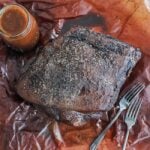

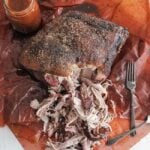
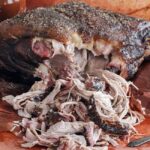
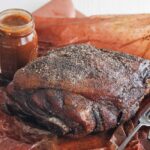
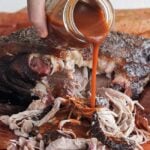
How do you get the Malliard reaction starting at 285 if you don’t set your smoker higher than 250 degrees as it says in the recipe. Thanks
time
Do you have a recipe for barbecued pork? I don’t have a smoker?
what would be considered BBQ pork and with what cut of pork? Grilled pork?
What we do is put aluminum foil or butcher paper wrapped pork in a cooler if hold over needed. Works great.
yup that works well also.
I have looked online on how to smoke on a gas grill, but he stated that you need to know how much/many wood chips you would need for a specific recipe. Do you have a recommendation on that for this recipe?
I’m not really understanding the question? When smoking food you continually feed the smoker with chips, pellets, or wood, until the food is done cooking if that makese sense.
Due to the lower cooking temperatures, you can expect this to take roughly 1 minute per pound of smoking, regardless of weight.
Don’t you mean to say that this will take 1 hour per pound of smoking regardless of weight?
yes, fixed it. Thank you!
This is the second time that I am sending. The first one was never posted. I’m wondering if you can tell me how to smoke this Smoked Pork Shoulder roast if you do not have a smoker.
Looking forward to your response to me
Vicki
I responded to the last one. There is no way to do it unless you set up your charcoal grill as a smoker.
Billy,
First I just want to let you know how much I enjoy your recipes.
You do excellent work.
Question…. I do not have a smoker and was wondering how to go about doing smoking. I do have a grill, a 3 burner Genesis Weber Grill and wondering if I could do it that way or if you could tell me how I can do this that would be great.
You cannot unless you use a smoker box.
Love your recipes. Thank you
My pleasure!